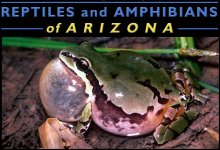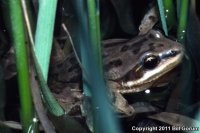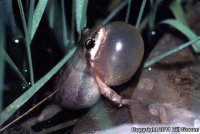| Range: |
 |
| Other Names: |
|
| Description: |
The Western Chorus Frog is a relatively small (to about 1.5 inches) frog with neither conspicuous toe pads nor significant webbing between the toes. This frog has a highly variable color pattern. It is light tan, gray, or brown on the back, sometimes with a greenish wash, but most have three dark stripes down the back that may be broken or replaced by lines of spots. The dark stripes or spots are absent in some individuals. There is also a lateral dark stripe that runs from the nostril through the eye to the groin area. A white line is present below that stripe on the upper lip of the frog. In cold temperatures colors of the frog darken. Males have a dark throat patch during the breeding season. Larger tadpoles are dark above and silvery below. Eyes are not positioned high on the head. They grow to about 1.5 inches prior to metamorphosis. |
| Similar Species: |
The Boreal Chorus Frog is almost identical to the Western Chorus Frog. It has shorter hind legs but is best distinguished by its call or location. |
| Habitat: |
This species is typically found on the ground or in low shrubs or grass at or near breeding ponds, which include often shallow and temporary ponds, cattle tanks, lake margins, wet meadows, and roadside ditches. Sites without fish are preferred for breeding. The species sometimes breeds in permanent water. This frog is rarely encountered outside of the breeding season. |
| Behavior: |
Shy and secretive, rarely seen outside of the breeding season. |
| Hibernation: |
|
| Reproduction: |
Breeding begins in the spring, often when ice and snow are still present. The male has a surprisingly loud call that sounds like "pprreeep" or someone running a finger down the teeth of a comb. During peak breeding periods, males call during the day as well as at night. Each female lays up to 1,500 eggs, which are deposited in small packets of 20-100, and are attached to submerged sticks, leaves, or grass. Tadpoles hatch in a few days to a week or more, and metamorphosis occurs in 6-13 weeks. |
| Diet: |
The Western Chorus Frog feeds upon a number of small invertebrates, such as flies, springtails, spiders, snails, and ants. |
Adapted from account on reptilesofaz.org
Sources:


|











